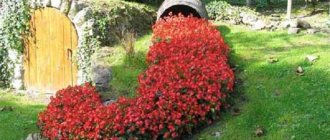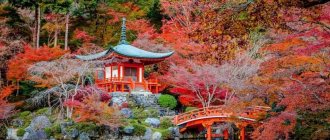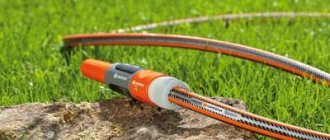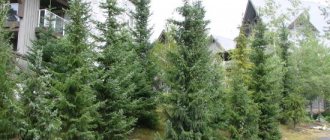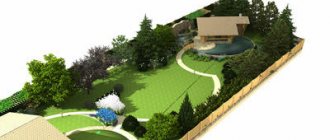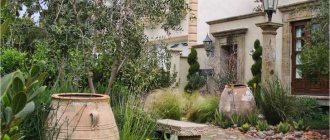While it may seem like winter is a period of rest for both plants and gardeners, we still have a lot of work to do. Snow, a little sun and cold temperatures can have a big impact on garden flora, so you need to look after them properly. What work needs to be done in the garden in winter so that you can enjoy its beauty in spring?
The main responsibilities for caring for a garden in winter are primarily control and preventive measures aimed at protecting plants from the harmful effects of low temperatures and other adverse weather conditions.
So, the main work that needs to be done in the garden at this time of year is:
Myth 1: The abundance of conifers solves the problem of decorativeness of the winter garden
Unlike beautifully fruited ones, evergreen trees and shrubs could well become a color accent in a leafless garden, but many winter-green deciduous plants are covered with lutrasil or snowdrifts for the winter.
We have to be content with conifers. Their assortment is endlessly large, but the main thing here is not to forget about a sense of proportion: an excessive variety of plants that fall within the limits of one glance creates unnecessary diversity.
How to fix the situation:
It makes sense to color the picture with decorative deciduous barks. The derens alone are worth it! Do not discount uncovered evergreen deciduous plants (magonia, pachysandra, periwinkle and others). Of course, they are of no use in winter, but when the snow has not yet fallen or has just melted, their emerald foliage will delight us.
And it is better to place covering plants in the summer part of the garden - where no one cleans the paths in winter. It must be borne in mind that some of the evergreen plants, such as privet, often shed their leaves in the winter in the middle zone, becoming deciduous.
And some deciduous plants - for example, hornbeams, on the contrary, retain foliage : it fades, but remains on the tree. Such plants should not be included in the winter garden picture.
Work in the garden and vegetable garden in February
The last month of winter. There is still time before spring work on the site, but you can do other important things. Most of them are related to preparation for the season.
Preparation of garden and vegetable crops
In February it is time to sow seeds for seedlings. Peppers, eggplants and some varieties of flowers can be prepared this month. In addition, now is a good time to take cuttings for grafting. In general, grafting of fruit crops is done in April. But we must remember that for good survival, an active and awakened rootstock is needed, but the scion must be dormant. Of course, in April it is almost impossible to find a dormant scion, when all the plants are awakening. Therefore, cuttings for grafting should be prepared in February. Also, you can immediately remove the snow instead of waiting for spring to come.
What else?
It will not be superfluous to put cuttings of coniferous crops for rooting. When propagating thuja and juniper in February, 90% of the cuttings take root. It is better to cut them from plants aged 4 to 8 years. It is recommended to carry out rooting in sphagnum moss, not forgetting to first treat it with a root formation stimulator. If everything is done correctly, then with the onset of spring the cuttings will have a powerful root system and can be planted in open ground.
Myth 2: Beautifully fruited plants are the main decoration of the winter garden
This is only partly correct: in the conditions of the middle zone, their winter decorativeness is somewhat exaggerated. They delight Western Europeans with their bright fruits for much longer. The climate affects the condition of the plants, and it is easier for birds to find food there - all our berries are eaten before the New Year.
In addition, the closer the site is to the city and highways, the faster the fruits lose their appearance. Fungal diseases that have developed strongly in recent years also have an effect. But even if you live in a village, the surrounding birds are well-fed, and there is no trace of disease, plants with decorative fruits will still play a supporting role in the winter garden. The reason is simple: lack of assortment.
How to fix the situation:
Nevertheless, a choice of beautifully fruited ones . You can plant barberries and hawthorns, species apple trees and roses, snowberries and sea buckthorn, euonymus and rowan. Then, at least in late autumn and early winter - in the darkest, dullest and least snowy times - they will attract attention from afar with their spectacular fruits.
Of course, the scarlet twig of Thunberg’s barberry, bent over the path, is just a pleasant little thing, and not a garden-forming element, but seeing it, each of us will experience positive emotions.
In addition, you can hang feeders. They will somewhat distract the birds from the bright fruits, and flocks of tits and bullfinches are in themselves a living and ringing decoration of the garden.
Work in the garden and vegetable garden in December
The first month of winter, in which a lot of things immediately appear. First of all, you need to whitewash all the trees. Of course, many summer residents are accustomed to the fact that this procedure is carried out in the spring. And this is correct, but in winter whitewashing helps protect the trunks from sunburn. No one forbids doing this in the fall, but only if it rains, even very resistant paint will be washed off. Therefore, December is ideal for whitewashing trees.
For this you can use the usual lime, to which copper or iron sulfate is added. This composition will protect the plant well from diseases. An alternative is to use acrylic paints. The fact is that they already contain additives to protect against pathogens. Although acrylic paints are expensive, they last much better.
There is one more point to consider. When whitewashing, you need to paint not only the trunk, but also the main skeletal branches. It is recommended to carry out the procedure during the onset of a thaw.
Shelter of coniferous trees
The problem with all young conifers is that they dry out in the first few days of spring. This is due to the fact that when the first warm rays of the sun appear, the needles begin to actively evaporate moisture. At this time, the roots are in frozen ground and cannot absorb water. All this leads to the fact that the plant begins to dry out.
This can be avoided if you take the right measures. It is enough to simply shade the crown. Fir and pine branches are best suited for this. You need to stick several strong twigs around the young tree and tie them into a bundle on top. The result will be something like a hut. Coniferous branches are laid on this structure and additionally tied to the frame.
Tying thuja and juniper
For all pyramidal conifers, another problem is relevant in winter. A lot of snow sticks to their branches and they can break. Therefore, in December it is recommended to tie all branches more tightly to the trunk.
Buying seeds
In fact, this is more of a recommendation. After all, now you can buy seeds at any time of the year. However, it is in winter that they are sold at large discounts, which will allow you to save significantly. Such sales are due to the fact that many seeds expire by the end of the year. According to current legislation, implementation should not exceed three years. But for most cultures this is not a problem. After all, tomatoes, beets, watermelon, peas and many others have a sales period of more than five years. That is why buying seeds is most profitable in December.
Myth 3: A tree with decorative bark will change the winter landscape
One trunk, even if very beautifully colored, is unlikely to change the picture of the winter garden. Imagine the coloristic effect of a lone birch tree in a field, then of a three-trunked one and, finally, of an entire birch grove - and you will understand what we are talking about.
How to fix the situation:
If you want your garden to impress guests even in winter, use multi-stemmed forms of ornamental bark plants or plant them using the bouquet planting method.
Three- or four-trunked Maak bird cherry trees, birches, greenbark maples, “Russian eucalyptus” poplars in winter will produce a much greater effect than single-trunked ones.
Ornamental bark shrubs are multi-stemmed by nature, but they should be regularly rejuvenated by planting them on a stump. It is on young shoots that the bark is the brightest. Such shrubs can be completely neutral in the summer and not attract attention to themselves, but when they shed their leaves, they immediately become almost the main accent. Such a change in points of attraction is very favorable, especially in small gardens.
Winter whitewashing of trees
A high-viscosity lime mortar is suitable for whitewashing. To prepare it, take 2-3 kg of freshly slaked lime or chalk, 100 g of PVA glue and 400-500 g of copper sulfate diluted in hot water per 10-liter bucket of water. The mixture should have the consistency of thick sour cream, without lumps. You can also purchase a ready-made solution (in specialized stores), or you can whitewash trees with acrylic paint - it does not wash off and reflects light well. In this case, several nuances should be taken into account.
- Firstly, young trees with smooth bark can only be whitened with lime mortar, but paint cannot be used, since it will not allow air to pass through.
- Secondly, before whitewashing, the trunk must be cleaned - dry bark, moss, lichens with a scraper or metal brush.
After this, the cracks are covered with garden varnish.
Myth 4: Non-ornamental plants are not noticeable in winter
Many trees and shrubs after leaf fall are not particularly interesting, neutral. But there are also those that you don’t even want to look at in their leafless state. Remember what Manchurian aralia, crown mock orange, uncovered tree peonies look like in winter... The list goes on. Such plants not only will not decorate the winter landscape, but will make it even duller. There is no “zest” in them - neither the bright color of the shoots, nor the patterned tortuosity of the branches. It would be nice if we just didn’t notice them, but they attract the eye with their “negative” decorativeness.
How to fix the situation:
Switch attention from ugly bare branches to something else, for example, to small architectural forms. Particular attention should be paid to their color. Sculpture in a winter garden is no less an accent than in a summer garden.
You can also play with color. Walls or fragments of them painted in warm colors, which are hidden behind emerald greenery in summer, will not only illuminate the garden in winter, but will also become a good backdrop for emerald conifers, coral turf, winding shoots of willow or hazel, and picturesque apple trees. After all, a beautiful pattern of branches can be appreciated only if the plant is located close to the observer and against a suitable background.
In a miniature space, even the inflorescences of some herbaceous perennials left over for the winter can give a graphic appearance.
Snow removal
The accumulation of snow on branches can lead to their destruction. For this reason, it is necessary to systematically shake off snow from trees and bushes. It is also necessary to regularly remove the ice cover that forms on the branches, which occurs as a result of significant temperature changes in winter. This occurs mainly in January and March, when the weather can be moody.
Removing excess snow in the garden will make our area safer for us and our family members, since it will make it more difficult for ice to form. The access road to the site must also be cleared of snow. Heavy snow and low temperatures can damage plants, causing them to become deformed. Lack of precipitation limits access to oxygen and retards their growth.
One of the easiest ways to get rid of snow and ice is to sprinkle it with kitchen salt, which can often be found on the street or on sidewalks. However, this solution is fatal to our garden flora. This leads to the formation of so-called physiological drought, when plants cannot take water from the ground and die over time.
For the above reasons, choose the traditional method of snow removal, especially since we have at our disposal tools that greatly facilitate this activity and make it easy and effective. These include:
Snow shovels
With the help of shovels, you can effectively clear our area of excess snow. However, it is important that they are strong enough so that they do not accidentally break in bad weather. Snow shoveling is an ideal solution for small gardens and cleaning up after moderate snowfalls.
The main advantage of using shovels is that with them we can reach almost any corner of our garden without worrying about destroying plants under the snow. We don't have to worry about where the snow will fall because we decide where to move it.
The most durable snow shovels are made of steel or aluminum. Plastic shovels, although cheap, unfortunately cannot cope with heavy and dense blocks of ice and snow. In addition, they often crack and break. Therefore, if we care about durability, the choice is simple.
When purchasing a snow shovel, pay attention to the gripper device. It is better to choose contour models. Then the work becomes less complicated and is done more efficiently; the handle itself is also more resistant to mechanical damage than a straight one.
Snow blowers
This type of device has proven itself especially well during heavy and frequent snowfalls. The use of snow blowers greatly facilitates and speeds up snow removal on the site. Due to the fact that essentially all the work is done by the machine, the task of clearing snow on the site becomes less labor-intensive for us, and we can spend the saved time on other, more important things in our garden.
Many homeowners criticize these devices for not being good at removing snow from uneven areas. Meanwhile, the latest and modern models of snow blowers can cope with snow removal even on sites with curved terrain. However, of course, they cannot be used everywhere, so having a shovel for removing snow in your country house is, in any case, a must-have accessory.
When choosing a snow removal device, first of all pay attention to the type of drive. They are:
Electric snow blowers
They remove snow using an electric drive. They work well for clearing snow in small areas because their range of operation is limited by the cable connected to the electrical outlet.
Such devices, as a rule, are small in size (30-40 cm), which makes them easier to work with. There are also no problems with storing them. However, compared to gasoline snow blowers, they have less power, which can make it difficult to remove snow from wet or frozen thick snowpack.
Although the noise level is certainly superior to gasoline models. Another advantage is that, due to their low weight, even women and children can use them.
Gasoline snow blowers
They are equipped with an internal combustion engine. Gasoline devices are ideal for clearing large areas of snow. They have more power than electric snow blowers. They also tend to be larger in size, which increases the width of snow removal.
These parameters make removing snow from the area with them an extremely effective, quick activity, without much effort. However, due to their weight and design, gasoline snow blowers are not suitable for women and children. Moreover, these devices produce more noise than electric snow blowers, but their range is not limited by any wires.
There are one- and two-stage combustion snow blowers. The former have less power because they are equipped with a two-stroke engine, while the latter have a four-stroke engine and all-wheel drive, which makes them easier to operate. For a small garden, a single-stage snow blower will suffice.
The two types of equipment also differ in design. In the case of single-stage devices, the drilling machine performs two operations simultaneously - it collects snow and throws it to the side. Two-stage snow blowers are equipped with a rotor that collects snow mass and an additional ejector that throws it in the desired direction.
Rotary plows
This equipment has the most power of all devices used for snow removal, which is also reflected in its size. Thanks to their large working width, rotary plows are ideal for clearing large areas covered with a thick layer of wet or frozen snow. However, if the amount of precipitation is irregular and the snow is not compact, it is better to choose a device with less power, which will simply be cheaper.
If your garden has winding paths, a powered rotary plow will be useful to make it easier to turn. During the winter, temperatures can get low enough to cause trouble starting the unit. For this reason, it is better to choose equipment equipped with an electric starter, which will avoid these troubles.
To ensure maximum working comfort when choosing a rotary plow, check out the additional equipment. Heated handles make snow removal even a pleasant experience even in low temperatures.
To summarize: 10 main points
What to do:
- use multi-stemmed trees with decorative bark or plant them using the bouquet planting method;
- install bird feeders to preserve decorative fruits on plants and diversify the picture of the winter garden;
- use evergreen uncovered deciduous plants for effect in late autumn and early spring, but do not clear snow from the paths on them in winter;
- plant shrubs with decorative fruits and branching closer to the points of perception.
And what not to do:
- use plants in the composition for the winter garden that will have to be covered for the winter;
- make plants with decorative fruits the only accents of the winter garden;
- plant low-growing plants in places where snow falls in winter after cleaning;
- planting within one glance a large number of conifers that are too heterogeneous in appearance;
- use “negatively” decorative plants in a leafless state;
- use plants that do not shed wilted leaves in the winter.
Protecting your garden in winter
When the temperature drops below 5 degrees, bulbs, tubers and perennials overwintering in the ground should be covered with dry leaves or branches of coniferous trees, which will provide them with protection from snow and frost. At temperatures below minus 10 degrees, it is recommended to cover them with thick fabric.
Thick snow cover can inhibit the development of flower bulbs and perennials. For this reason, in winter it needs to be cleared off, but not completely, because snow is a kind of natural protection for plants from frost. However, if you are dealing with ice, you definitely need to get rid of it, otherwise the plants will not have access to oxygen and will die.
Did you find this article helpful? Please share it on social networks: Don't forget to bookmark the Nedvio website. We talk about construction, renovation, and country real estate in an interesting, useful and understandable way.
Types of structures and interior design
The main requirements for the design of a winter garden:
- it should be well lit,
- have an attractive appearance both inside and outside,
- be strong and withstand extreme weather conditions.
The most common option is a rectangular, translucent extension to one of the walls of the house, with a pitched roof. There are also corner designs and combined ones. _______________________________________________
I wrote more about how to arrange a winter garden in this article _______________________________________________
Adjoining winter garden
The winter garden can be attached to the wall of the house or mounted as a free-standing structure, which is connected to the house by a transparent tunnel or blind passage.
Built-in winter garden
Located inside a residential building or apartment. In apartment buildings, a loggia or balcony is used for these purposes.
Photo: winter garden attached to the house
Decorative fruits and cones
The decorative value of fruits, which is determined by the size, originality of shape, brightness of color, abundance of fruiting and duration of preservation on the branches, is most evident at a time when black and white winter begins to cover gardens and parks. The fruits of rowan, viburnum, medlar, rose hip, hawthorn, snowberry, mahonia holly, barberry create bright accents in gloomy weather and perfectly lift the mood. Catalpa, honey locust, sycamore, and bladderwort are distinguished by their original form of fruits in winter. Fir, Weymouth pine, spruce and many other conifers decorate their evergreen crowns with cones.
Ornamental grasses in winter
A winter landscape can be decorated with frosted ears of cereals and dried leaves of ornamental grasses, which retain their attractiveness for a long time. Snow-covered cushions of gray fescue and Australian pennisetum look unusual. Thanks to tall ornamental grasses, such as Chinese miscanthus and reed grass, which proudly resist snowflakes and set the dynamics in the garden, there is no feeling of drowsy nature.
Natalya Vysotskaya, candidate s. -X. Sci.
With questions and comments on this article (and not only), you can contact Natalya directly on our garden forum.
© 2012 - 2014, Planting a Garden. All rights reserved.

